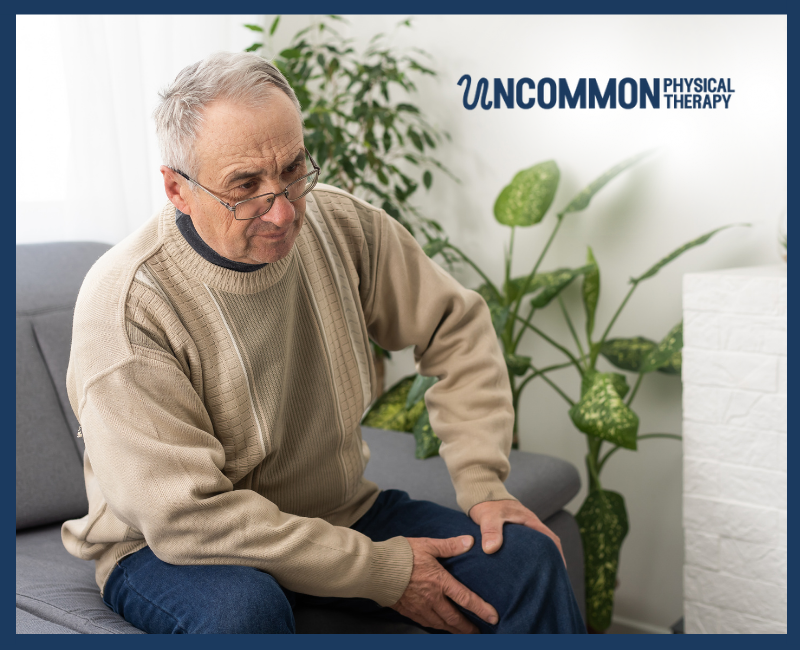Tired of letting joint pain hold you back? You’re not alone! Millions of people face the daily challenge of managing discomfort while staying active. Here is your passport to a world where you can embrace movement, defy limitations, and rediscover the joy of an active life. If you have questions — or want to explore a personalized program — we are here!
Physiotherapy Exercises for Joint Pain
When you’re active or upping your exercise goals, the last thing you want is to be sidelined with joint pain. Joint pain affects people at all stages of life from student athletes to seniors. Pain can be a big barrier to not only maintaining a regular exercise program, but also getting started. These strategies can help keep you active.
Assess Where You’re At
A good first step if you want to start a regular routine or up your exercise goals is to check with your primary care provider or see a sports medicine specialist who can assess your overall fitness level, general mobility and if you have current injuries or pain.
They also may conduct a functional movement screening to evaluate how you move and pinpoint specific issues. For example, you may have decreased range of motion in a hip or shoulder, or are stronger on one side than the other. This screening can identify specific rehabilitative exercises that can be done along with your regular exercise program.
These exercises help your body move safely, perform exercises correctly, and reduce the risk for injury or make symptoms worse. These findings will help build a program that’s going to be safe and effective for you and let you exercise as pain-free as possible.
Joint Relief Exercise Routine
Whatever your level of fitness, a good exercise routine should be sustainable. Regular exercise provides a host of health-related benefits, including reducing risk of cardiovascular disease, managing weight, maintaining strength and flexibility, and supporting bone health.
It Also Should Encompass a Combination of Activities:
- Cardio, which increases heart rate and improves your overall cardiovascular fitness. This includes vigorous walking, swimming, biking, playing pickleball, or taking a dance or water fitness class.
- Strength, which builds and strengthen muscles, improves overall function and improves performance in the gym, as well as activities of daily living. Strength activities include weight training, working with resistance bands, climbing stairs and exercises such as pushups, situps and squats.
- Flexibility, which stretches muscles and ligaments and promotes range of motion. Stretching, yoga, tai chi and Pilates all focus on flexibility.
And finally, regular exercise doesn’t mean just going to the gym, taking a class or following an online exercise program. It also means moving throughout the day, especially to break up periods of sitting. This unstructured exercise may be sweeping the floor, walking in place by your desk or doing some simple stretches when you first get up or before you go to bed.
Customize Exercise to You;
Sore muscles after exercising, especially if people are new to exercise and working on increasing their activity level, are normal. But sharp or ongoing pain may indicate an injury or chronic problem.
Some Points to Keep in Mind Are:
- Ease your way into a new exercise program. Try not to go from 0 to 100 overnight, since that may increase your risk of injury.
- Listen to your body. Don’t overdo it. Take a break or tone down your activity for the rest of the day.
- Keep a small problem small. If you’re feeling recurring pain, get it checked out.
- Build in time to recover between activity sessions. Our bodies need this time to rebuild and repair.
Another strategy is to work with a physical therapist, sports medicine specialist or trainer to determine the right and wrong way to do an exercise, or strengthen muscles to support a particular movement or joint. For example:
- If you suffer from low-back pain and are not able to perform a traditional barbell back squat exercise, you could do a modified version: either a split squat (one leg at a time) or rear-foot-elevated squat. These variations target the same muscle groups, but apply external resistance in the form of dumbbells or kettlebells at your side instead of on your back.
- If you have knee pain, using a reverse lunge or hex-bar squat helps reduces stress on your knees and allows you to target the same muscle groups.
- If you aren’t able to perform pushups or variations of the bench press without pain in your upper body, switching to a neutral grip position can reduce stress on the shoulder. Make sure to align the arms in a 45-degree angle with your torso to reduce stress on the shoulder and minimize pain.
Working with an exercise specialist can help you develop a plan that is specific to you and your abilities.
When joint pain begins to restrict the activities you love, it’s time to consult with an orthopedic specialist. Together, you’ll map out a plan for treatment to keep you moving and enjoying life. Orthopedic providers have a wide variety of options in their treatment toolbox. These options range from least invasive, such as physical therapy or medications, to more invasive, including injections or surgery. Their goal is to get patients back to the lives they want to lead.
Joint Pain Treatment and Break Down Barriers
Joint Pain is Just One Barrier to Regular Exercise. Others Include:
- Time
To start and maintain regular exercise, people need to carve time out of their schedules. Recent research shows that even short 5- to 15-minute workouts throughout the day can provide health and fitness benefits. Finding these little pockets of time and a consistent workout can go a long way. - Knowing Where to Start
Doing an online search for workout programs can yield overwhelming results. Once again, sports medicine specialists can provide guidance toward a program that best fits your goals. The choice of workouts should be ones you enjoy and can stick with. - Motivation
Whether it’s getting started or keeping going, lack of motivation can sink workout resolutions. One successful strategy is to review goals as a reminder of why you want to exercise, whether it’s to keep up with the grandkids, feel better or lose weight. - Being Realistic
Build a foundation by setting goals that can be accomplished in small segments, with each building on the next. For example, if you’re just starting, a walk around the block might be a first step, not signing up for a 5K.
The benefits of regular exercise are both physical and mental. Make sure you play the long game when it comes to your exercise program. Find a style of exercise that works for you long-term and that you can incorporate into your daily life.
Unlock the secrets to a pain-free, active life! Our expert team of physical therapists is here to help! Whether it’s targeted exercises, manual therapy, or personalized treatment plans, we’ve got the tools to get you moving with ease. Schedule your appointment today at (704) 803-8038. For more inspiration and tips, you can follow us on Instagram.
Reference: [https://www.mayoclinichealthsystem.org/hometown-health/speaking-of-health/staying-active-with-joint-pain]





